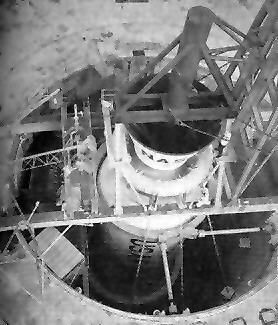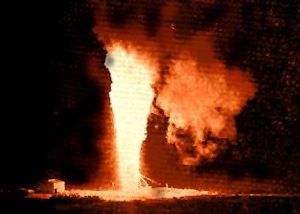
Home - Search - Browse - Alphabetic Index: 0- 1- 2- 3- 4- 5- 6- 7- 8- 9
A- B- C- D- E- F- G- H- I- J- K- L- M- N- O- P- Q- R- S- T- U- V- W- X- Y- Z
AJ-260
 AJ-260 Motor Credit: Aerojet |
Since solid rocket motors have to have their fuel loaded at the factory, there are two possible approaches to their design when used in large launch vehicles. The first is that they be built in segments, transported by rail to the launch site, and assembled there. Rail limitations in the United States limited such motors to 156 inches in diameter. The other alternative was the ‘monolithic' motor. As with smaller motors, the propellant is cast in the motor casing at or near the launch site and then move it by barge to the launch pad. This was potentially a safer approach, since any problems with the joints of a segmented motor could lead to catastrophic failure of the motor. When USAF and NASA developed a solid-propellant equivalent to the Saturn V first stage during the 1960's, the monolithic concept used. The result was the largest rocket motor ever fired.
Work on large monolithic motors had begun as early as 1960 in support of the Titan 3 program. Aerojet did participate briefly in the 120" monolithic motor concept - to the extent of doing design studies, and test loading a feasibility unit. But the final decision on Titan 3 was to go for the segmented design of CSD. Much of the early 156 inch diameter motor development work was also done on monolithic configurations. However again the USAF preferred the segmented approach, believing barge deliveries to its primary Vandenberg to be operationally constraining. Both the Lockheed and Thiokol test 156 inch motors were segmented. The main example of a large monolithic solid rocket motor was the Aerojet 260 inch.
Initially AFRPL had management and technical responsibility for both the 156" and 260" programs, and in 1963 parallel contracts were let to Aerojet and Thiokol for the development of 260" space boosters. The 1965 modification to the DoD/NASA agreement granted full responsibility for the 260" to NASA Lewis Research Center (LeRC), while development of smaller-sized boosters remained with the Air Force. Aerojet acquired a property in Florida 50 km south of Miami, 22 km northeast of Homestead Air Force Base. The site (74,335 acres, mostly in the Everglades) was accessible by barge so that the finished motors could be easily transported the 400 km north to Cape Canaveral.
At the same time that motor design started, work began on the enormous facilities required for the motor and propellant production, static testing, and supporting activities. All of these functions were conducted in a single integrated facility. The basic motor casing and nozzle would be processed horizontally, then lowered nose-first into a huge below-ground silo, with the nozzle exit at ground level. All chamber preparation, insulating, propellant casting, core removal, nozzle assembly, and test firing would be done in this vertical, nozzle-up position. Both continuous mix and two-batch mix propellant production facilities were constructed. There was considerable concern about building such a huge facility below the water table, but the 50 m depth proved no problem for a competent caisson contractor.
Dick Cottrell, Vice President of the Aerojet Solid Rocket Plant, was program manager for the 260 inch motor, while Paul Datner ran the Florida site. Test director was Will Spratling. The entire project was a monumental undertaking requiring many Aerojet staff to be moved from Sacramento to the new facility in Florida.
Metal chambers of the size required were unheard of in the rocket industry, but only about two thirds the diameter of the similarly highly stressed Polaris submarine hull. The Air Force took a strong hand in the specifics of the chamber design, requiring that both Thiokol and Aerojet use rolled plates of 18% Nickel maraging steel. Experience was limited with this material. Thiokol went along with the Air Force's desired low cost weld tooling and procedures, as well as heat treating to the 250 Ksi strength level. Aerojet used a more conservative approach. This entailed using a more complex, accurate, and sturdy weld positioning tooling, better plate preparation in the weld areas, a more forgiving multi-pass welding technique with extensive inspection, and heat treating to only 200 Ksi. The resulting chamber was more expensive, but also had more ductility. On hydrotest the Thiokol chamber burst at half of proof pressure, but the Aerojet chambers all survived. This washed Thiokol out of the competition.
Aerojet procured its chambers from Sun Shipbuilding, using a Ladish roll forged "Y" ring section, and a TRW nozzle. This was fabricated with a tape-wrapped carbon phenolic throat that was pressure cured. The PBAN propellant was mixed in both the batch and continuous mixers, with no discernible difference in performance or physical properties. Aft end ignition was supplied by a small rocket motor that was tethered to restrict its point of impact after being ejected by the main gas flow. The first chamber, delivered by barge, arrived with a hurricane in the vicinity. The barge was tied to a dock, but was torn loose and beached - but the chamber was undamaged.
The SL-1 and SL-2 short length motors were essentially identical - the full length was not required for the demonstration program. The short length motors were 24 m long and capable of about 1,600,000 kgf thrust for 114 seconds. Thrust would be twice as much for the full length motor, with a duration of more than two minutes. Both motors used a propellant burning rate and nozzle size appropriate for the full length design. SL-1 was fired at night, and the flame was clearly visible m Miami 50 km away. Test of the SL-2 was similarly successful and uneventful. The third SL-3 motor used a partially submerged nozzle and produced 2,670,000 kgf thrust, the largest ever for any solid (or liquid!) rocket in the world. Near burnout, part of the nozzle was ejected, and design total impulse was not obtained. This marked the end of all firing tests, and the hulk of SL-3 was still sitting in the silo as of the 1990's
A fourth chamber using a fiberglass casing was built by Aerojet Azusa but not even hydrotested before funding was cut-off. Aerojet mothballed the Florida facility and waited for the US government to come to its senses. After the Challenger and Titan 3 disasters with segmented motors it was thought that NASA or USAF would finally turn to safer monolithic designs. But it was not to be, and Aerojet finally sold the facility in 1992. As of 1999 the South Florida Water Management District owned the Aerojet property. The firing pit and the blockhouse were still in place, along with most of the other buildings.
| AJ-260-1/3 Aerojet solid rocket engine. Design concept 1960's. Used on Saturn INT-05B launch vehicle. Solid propellant rocket stage. Study NASA 1969. |
| AJ-260-2 Aerojet solid rocket engine. 260 inch solid rocket booster half length. The version tested and also proposed for use as a first stage with the Saturn IVB. Solid propellant rocket stage. 260 inch solid rocket booster half length. |
| AJ-260X 1/3 Aerojet solid rocket engine. Design concept 1960's. Solid propellant rocket stage. 260 inch solid booster - full length. Saturn 3S second stage. |
| AJ-260X Aerojet solid rocket engine. Study 1967. Full length version of 260 inch motor tested in 1960's. Proposed for use in various Saturn and Nova configurations. Solid propellant rocket stage. 260 inch solid booster - full length. These would have been the flight configuration motors, replacing the Saturn V first stage or being used as booster motors in various Uprated Saturn and Nova configurations. Solid propellant rocket stage. Boeing study, 1969. Solid propellant rocket stage. Boeing Low-Cost Saturn Derivative Study, 1967 (trade study of 260 inch first stages for S-IVB, all delivering 86,000 lb payload to LEO): Low Cost Booster, Solid Propellant. |
 | AJ-260 Firing Credit: Aerojet |
Back to top of page
Home - Search - Browse - Alphabetic Index: 0- 1- 2- 3- 4- 5- 6- 7- 8- 9
A- B- C- D- E- F- G- H- I- J- K- L- M- N- O- P- Q- R- S- T- U- V- W- X- Y- Z
© 1997-2019 Mark Wade - Contact
© / Conditions for Use